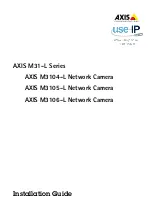
89
The following section details all the attributes displayed on the status page:
Link Name:
The link name is allocated by the system administrator and is used to identify the
equipment on the network. The link name attribute is limited to a maximum size of 63 ASCII
characters.
Link Location:
The link location is allocated by the system administrator and can be used as
a generic scratch pad to describe the location of the equipment or any other equipment
related notes. The link location attribute is limited to a maximum size of 63 ASCII characters.
Software Version:
The attribute describes the version of software installed on the
equipment. The format of the attributes is
FFSSS
-XX-
YY
where
FF
is the frequency variant
(2.5, 5.4 or 5.8GHz),
SSS
is the System Release,
XX
is the major release version and
YY
is
the minor release version.
Hardware Version:
The hardware version attribute contains all the combined hardware
version information. The attribute is formatted as D
XX
-R
YY
-
Z
where D
XX
contain the version
of the digital card, R
YY
contains the version of the RF (radio frequency) card and
Z
describes
the antenna type which can be I (integrated) or C (connectorized).
Region Code:
The region code is used by the system to constrain the wireless to operate
within regulatory regime of the particular country. The region code is encoded in the product
license key. If the operator wishes to change region code, a new license key must be
obtained from Motorola or the local point-to-point distributor / system integrator.
Elapsed Time Indicator:
The elapsed time indicator attribute presents the total time in years,
days, hours, minutes and seconds since the last system restart. The system can restart for
several reasons, e.g. commanded reboot from the system reboot web page, or a power cycle
of the equipment.
Ethernet Link Status:
Current status of the Ethernet link. A state of ‘Up’ with a green
background indicates that an Ethernet link is established. A state of ‘Down’ with a red
background indicates that the Ethernet link is not established.
Summary of Contents for MOTOWI 4 PTP 600 Series
Page 1: ...PTP 600 Series User Guide MOTOROLA POINT TO POINT WIRELESS SOLUTIONS ...
Page 2: ......
Page 24: ...22 List of Equations 462HEquation 1 Path Loss 955H63 463HEquation 2 Link Loss 956H91 ...
Page 113: ...111 8 3 3 Detailed Counters Page Figure 53 Detailed Counters Page ...
Page 221: ...219 Figure 136 Disarm Following TDD Synchronization ...
Page 227: ...225 Figure 142 Diagrammatically Showing the E1 T1 Connections ...
Page 228: ...226 Figure 143 Two E1 T1 120 Ohms signal Balanced to PTP600 Interface ...
Page 230: ...228 Figure 144 Typical Mast Installation with the addition of the E1 T1 cable ...
Page 233: ...231 Figure 146 Surge Arrestor ALPU ORT Connection Illustration ...
Page 237: ...235 Figure 149 QPSK 0 63 Single Payload Figure 150 QPSK 0 87 Single Payload ...
Page 238: ...236 Figure 151 16 QAM 0 63 Single Payload Figure 152 16 QAM 0 87 Single Payload ...
Page 239: ...237 Figure 153 64 QAM 0 75 Single Payload Figure 154 64 QAM 0 92 Single Payload ...
Page 240: ...238 Figure 155 256 QAM 0 81 Single Payload Figure 156 16 QAM 0 63 Dual Payload ...
Page 241: ...239 Figure 157 16 QAM 0 87 Dual Payload Figure 158 64 QAM 0 75 Dual Payload ...
Page 242: ...240 Figure 159 64 QAM 0 92 Dual Payload Figure 160 256 QAM 0 81 Dual Payload ...
















































